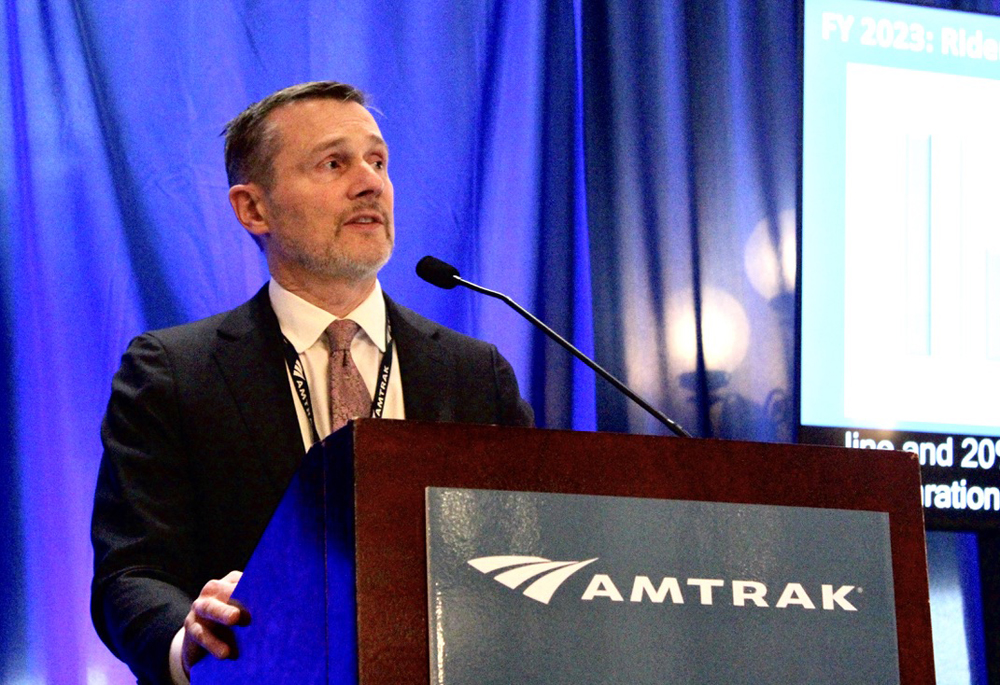
RICHMOND, Va. — Amtrak projects that it will surpass pre-pandemic figures for ridership and revenue in 2024, company officials said Friday as executives joined the board of directors for the company’s second annual public meeting, an event mandated by 2021’s Bipartisan Infrastructure Law held this year at Richmond’s Main Street Station.
This year’s gathering was significantly more informative than the initial meeting last year in St. Louis, in part because top managers and department heads, along with the leaders of North Carolina and Virginia passenger rail programs, were available in a pre-meeting “Expo” to explain various initiatives [see “Hands-on ‘Expo’ …,” Trains News Wire, Dec. 2, 2023].
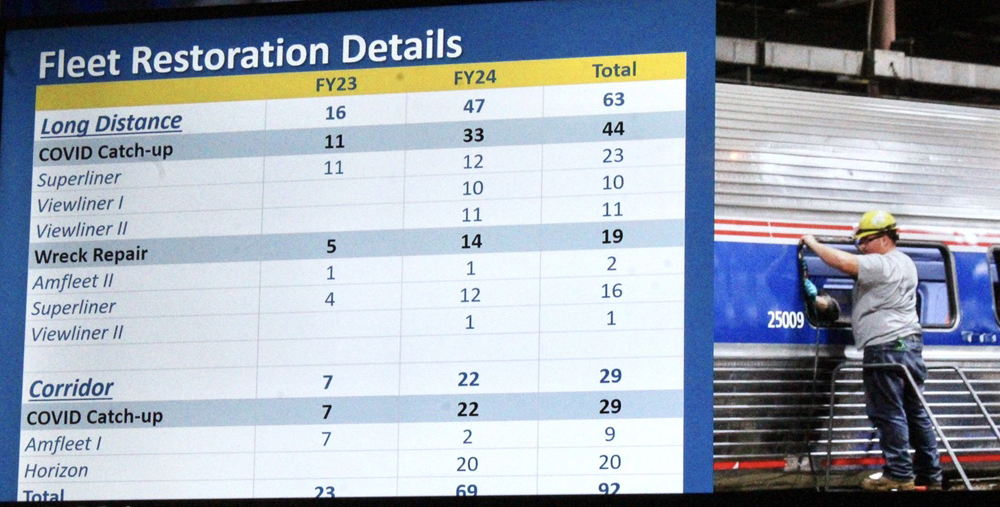
Amtrak President Roger Harris recapped financial results released a day earlier [see “Amtrak cites major ridership increase …,” News Wire, Nov. 30], primarily comparing fiscal 2023 with the previous year. He noted that long-distance service were successful because “for the second year in a row it beat the half billion dollar benchmark.” The state-supported aggregate suffered because California’s Pacific Surfliner corridor was disrupted by mudslides, while the Acela service line suffered from weakened business travel and reduced frequencies due to four out-of-service trainsets. [Trains News Wire is preparing an in-depth revenue and ridership analysis incorporating a comparison with pre-pandemic 2019 results and a focus on individual routes and corridors.]
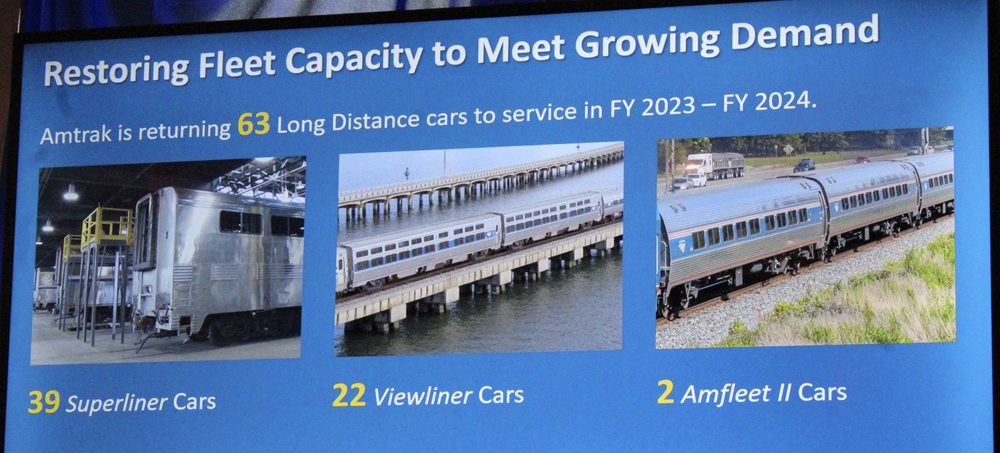
Regarding on-time performance, Harris says there have been challenges on the Northeast Corridor as a result of trackwork, though host railroad metrics have improved. He also presented tables outlining long-distance fleet restoration efforts by equipment type, as well as progress on a “fleet refresh” upgrade initiative. Twenty-three Superliner coaches are being refitted with fully-accessible bathrooms.
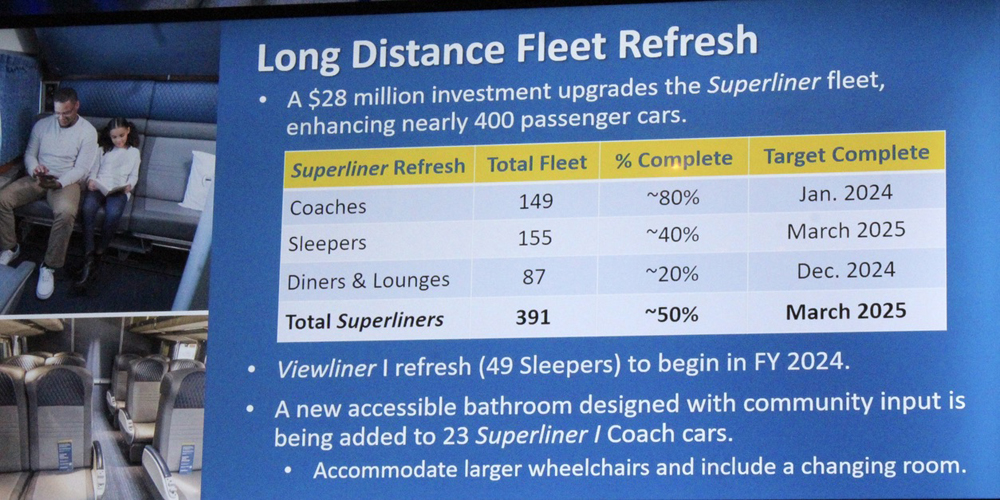
“The good news,” Harris says, “is that by the end of fiscal 2024 we will have worked through all of the backlog and will have 2,205 cars in service versus 2,224 pre-Covid.”
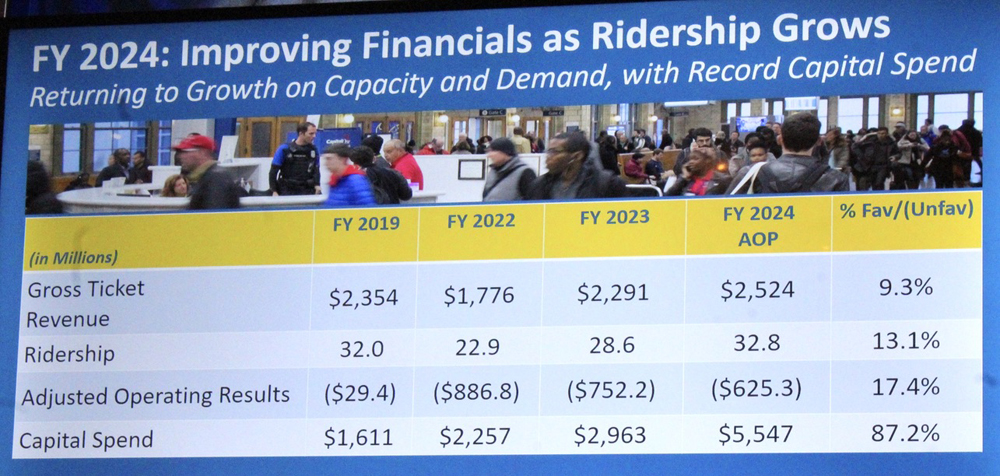
The company’s projections for fiscal 2024, which began in October, are a 13% ridership increase to 32.8 million passengers with a 9% revenue gain to $2.5 billion, surpassing 2019 figures. Operating losses are expected to decline, while capital expenditures are set to grow 87%.
“Our goal is to achieve 66 million riders by 2040 to make a much bigger contribution in mobility,” Amtrak CEO Stephen Gardner says. His top four goals: Expanding partnerships and adding service “particularly to the Top 50 metropolitan areas,” along with “serving the right communities with high-speed rail” while attaining a net-zero emissions goal. “To do this,” he says, “we absolutely need a stable and secure source of long-term capital investment. It’s what is transforming the nature of our business today with five years of dedicated funding to launch projects with money we know we have the ability to finish, not just start.”
Q-and-A session is wide ranging
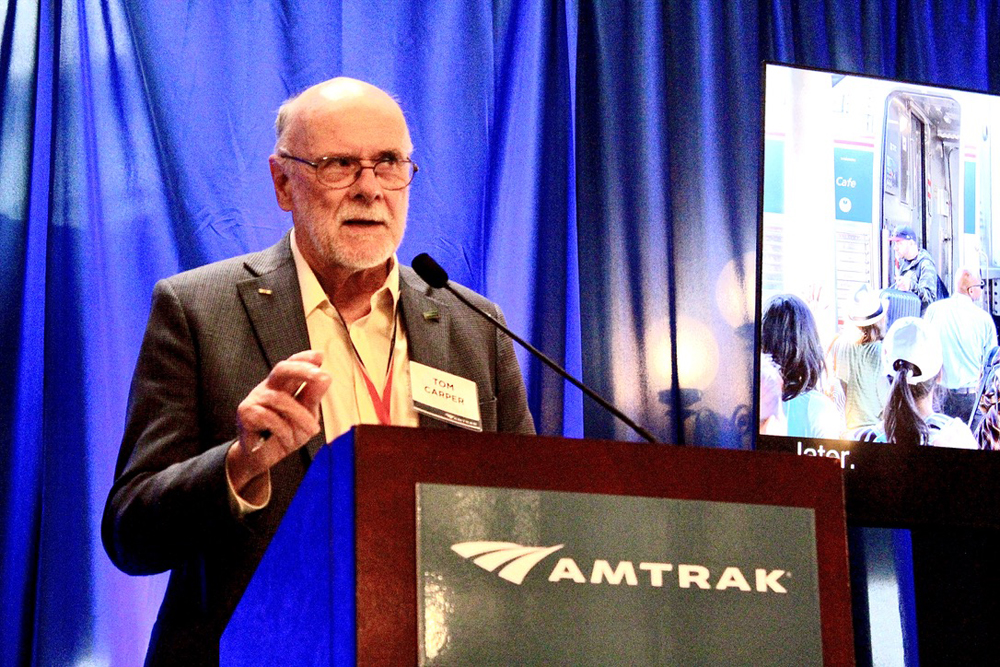
Prior to the officer reports at the beginning of the session, board members Jeffrey Moreland, Yvonne Burke, and Federal Railroad Administration Administrator Amit Bose covered aspects of the year’s financial performance. Coscia said former Amtrak chairman Tom Carper would discuss ridership, but no numbers were forthcoming.
Clearly deciding to go “off script,” Carper — the resident and former mayor of Macomb, Ill. — described how changing workplace norms have created more opportunity for people to seek communities with a slower pace, great environment, and better quality of life. “They also need reliable broadband provided and transportation to nearby urban areas. And that’s us: we’re providing that right now,” Carper said. “Trying to recruit a hospital administrator to a rural area is really difficult, but much less so if you [have the opportunity] to get on a train several times a day and get to the city. That’s part of the package Amtrak has offered since it started. … I thought it was important for you to know what’s going on right now — a lot of positives. We’re doing as good a job as we can, and we need to keep your support.” The crowd applauded.
The meeting also included senior executives answering public questions on topics including:
Service Disruption passenger notification. “With our new system,” Harris said, “we are able to get timely information to customers. We have increased our notifications to customers from one million to 24 million messages during the past year. It’s terrible when there is any kind of delay but it is so much worse when we don’t tell people what’s going on.”
Superliner deployment on state-supported trains. Harris said California has refurbished Superliners on long-term leases and Canadian National requires the long-distance cars for axle count to activate signals on the Chicago-Carbondale route [see “Seeking answers on ‘loss of shunt,’” News Wire, Sept. 6, 2023]. “Absent those situations, we need to get the right equipment in the right places,” he said. Not addressed was whether this need was taken into account when the company was making return-to-service decisions on sidelined equipment.
Dining service and coach customer participation. “As we bring Viewliner diners back into service, next on the [New York-New Orleans] Crescent, we will determine what kind of food service works for that train and those hours of operation,” Harris said. “The question really is how much capacity is there to serve coach passengers. That’s what we worked through [for traditional dining] on our western trains without impacting the quality of service.”
Executive bonuses. Coscia addressed this frequent target of critics, congressional and otherwise. He explained that the company used to have a fixed benefit program — in other words, pensions — but replaced that with a bonus plan “tied directly to the company [performance]. The metrics used to determine bonuses are not just financial metrics, but are metrics related to customer service, on-time performance, and the ability to provide more ridership opportunities. Having said that, financial performance is obviously relevant in demonstrating the company’s ability to be good stewards of the assets we are given.” Exactly how these metrics are applied to mid-level positions has never been spelled out in detail.
Why all board meetings aren’t public. “We have agreements with private parties,” Coscia said. “We would be revealing not only confidential information but giving away most of our bargaining power in the marketplace. No business can operate that way from the standpoint of making critical decisions.” He added that “it is absolutely critical” that the company communicate “where we are operating well, and where we are operating poorly.”
Crews taking up tables in café cars. “One conductor might need to sit in one seat, but they shouldn’t monopolize tables in the area,” Harris said. “It’s something we’re working on from an enforcement perspective.”
Dirty windows. “We have a robust car wash replacement program around the system,” Harris said. “In the meantime, we are working on an interim program at key stations.” News Wire had been advised of this multi-year program earlier in the year; a report is awaiting a schedule of the expected dates and locations new washing facilities will become operational.
Adirondack cancellations because of heat-related track issues. “Our chief track engineer is working with Canadian National to make sure we have the physical plant that can be more robust,” Gardner said.
Lack of national network advertising. “The challenge has been that national media is very expensive,” Harris said. “What we’ve found is advertising online is a far more effective return on investment and use of our pretty limited advertising dollars. Also, regional media and cable is far more important. We don’t spend a lot of money on marketing because we don’t have a lot of money to spend.” Gardner added that budgets and promotions are timed to occur when capacity is available. “We usually sell out our sleeper space months before we hit the summer,” he said.
Board Chairman Coscia concluded the session by noting, “One thing is crystal clear: people want to ride our trains. I wish we had more to offer, but that’s what we are working [on] together toward the future.”








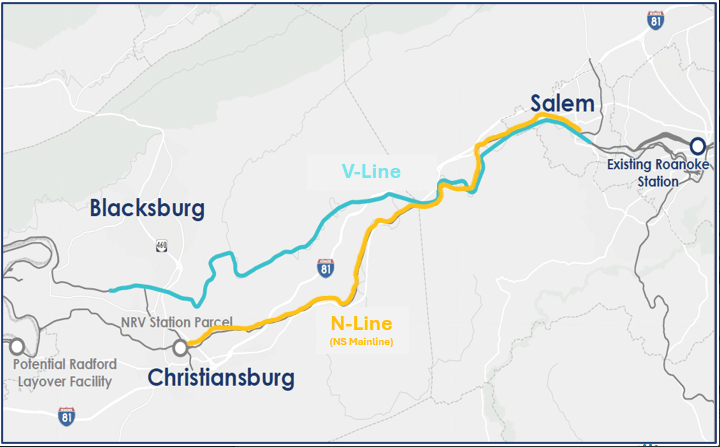
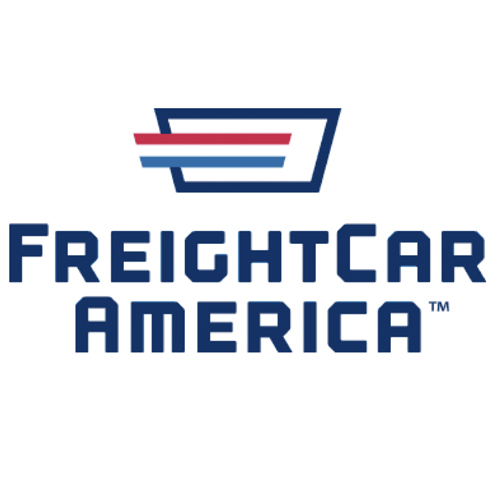




This is yet another superb example of Bob Johnston’s careful and thorough reporting. I particularly appreciate his capture of some of the very interesting Power Point slides presented.
I was one of the folks able to participate through Zoom in the Amtrak Board of Directors “public” meeting. There was nothing radically new revealed, but I did get answers to several questions through their response to Q&A questions I submitted through Zoom, which was unexpected. I’ll summarize those responses in a moment, but first permit me some general observations.
I want to note though that Amtrak representatives took a very positive tone at this session and were respectful (and receptive to listening to) all participants.
It is a misnomer to call this a public Amtrak Board meeting, as the actual formal Board meeting took place in the morning and was not open. What was offered was similar to a media presentation and then a public hearing. But it was well worth three hours time!
From 100-230PM Amtrak presented a slide program on its 2023 accomplishments and some future plans, and provided a forum for the Virginia and North Carolina DOT passenger chiefs to explain their on-going efforts to expand service (and speed it up) in those states. This was interesting, although if you follow the rail media there was really nothing not known before coming into this session–except perhaps the remarkable patronage surges continuing in both states. I don’t mean to be dismissive here. The state/Amtrak partnerships are vital nationwide and Virginia and North Carolina have much to show for their investments.
I was pleased to hear that as track upgrades are completed Virginia plans “near hourly” service Richmond to Washington and to add further trains to Newport News and Norfolk and is actively working to extend the Roanoke trains to the New River Valley in western Virginia. North Carolina sees another frequency for the Piedmont Corridor and future extensions to Asheville, and Wilmington, plus the restoration of the old Seaboard Airline Railway “S LIne” from Raleigh, NC to Petersburg, VA, which they anticipate will take an hour out of CAROLINIAN running times.
From 230-400PM was the public Board Meeting. This began with brief remarks from Board Chair Anthony Coscia and Board members Tom Carper and Amit Bose (the FRA administrator), followed by several slide presentations by Amtrak Vice Presidents. This included brief views of possible car designs and further discussion of “Amtrak Connects” new and upgraded route possibilities.
But mostly this was a Q&A and that represents its best value to advocates. In-person attendees were given a opportunity to ask detailed questions (and briefly to follow-up on the answers), while Zoom attendees could submit written questions through a Zoom Q&A portal and, happily, those questions were not lost in the Zoom ether. For example as I noted, four of my five Zoom queries got addressed. I wasn’t satisfied necessarily with all of the answers, but they were evaded either.
I hope Amtrak and/or the RPA will post the public presentations and the meeting Q&As shortly. I will share my questions that got answered, and quickly note what was not.
I asked if the Superliner coaches leased to California might be recalled to increase long haul capacity, as California is now taking delivery of an entire fleet of new Siemens Venture cars. Amtrak President Roger Harris dismissed this idea because California has paid to renovate the leased Superliners. That did not address why they should stay in California indefinitely–at least not if California won’t actually buy them.
Harris also addressed a related suggestion. I had asked if the Superliners assigned to run as empty axle count cars to the SALIKI and ILLINI Chicago-Carbondale trains might be released to revenue service. Sleepers and diners, as well as coaches, have been forced into this rotation to satisfy the CN’s contention that only 7-8 car trains are long enough to trigger their signals and gates. I asked if Amtrak might utilize some leased/borrowed first generation commuter cars from NJ Transit or Metra, in lieu of vital Superliners running empty daily. Bob Johnston at Trains covered this situation recently and Harris echoed Bob’s article by saying he hoped a solution was at hand, but did not describe what that might be. Essential he hoped for “something soon”.
I asked if Amtrak had considered offering a lie-flat bed accommodation as a moderately priced sleeper upgrade (“Slumbercoach”) on its soon to be ordered new long-haul fleet. Amtrak’s Norm Ford responded that they thought this was probably inappropriate on multi-night routes. Because there was no chance to interact/follow-up through Zoom I couldn’t point out this was not to replace regular coach or sleepers, but to offer an alternate revenue stream between low coach and usually staggeringly high First Class sleepers.
And frankly the fact that many of the long hauls run for two nights out (three on the combined TEXAS EAGLE/SUNSET) is the very reason lie-flat bed seats would be a very popular option for those in coach who couldn’t afford a full First Class sleeper upgrade. Amtrak clearly does not “get” what a benefit and sales asset this would be!
The answer I did like came from Mr. Harris in response to my question asking if they would stop the practice on the LH trains with only a single diner-lounge car (think the TEXAS EAGLE, CAPITOL LIMITED, CRESCENT, CARDINAL) of the crew taking all the lounge seats as “crew rest areas”, thus preventing coach passengers from enjoying the ability to socialize, eat and relax in a lounge setting as well as at their seats. Harris responded that he was aware of this, felt it was wrong and that there would be a concerted effort to stop this. If this happens I will be truly grateful. This practice truly twists the knife on coach riders. Not only are they still excluded from the ability to buy a proper meal in the diner on all eastern routes, as well as on the TEXAS EAGLE, CITY OF NEW ORLEANS and CAPITOL LIMITED Superliners, but insult is added to injury if they can’t even socialize in the lounge car.
Another attendee asked the obvious follow up question–eg. when will “Traditional Dining” be restored on the routes still offering only the “Fresh and Contemporary” (TV Dinner) menu and when will all Amtrak diners welcome coach riders. The news here from Mr. Harris was the suggestion that their next food service priority will be to restore diner service on the CRESCENT. As to coach access, to paraphrase a vague answer they “are working on it” but did not commit to a date. The excuse that “we’re working out the kinks” in the service on the Silver Fleet trains is getting a bit old. They key to coach access on trains like the SILVER METEOR will be adding a server to the dining car crew. This will be true on the LAKESHORE, CRESCENT, CARDINAL, TEXAS EAGLE, CITY OF NERW ORLEANS and CAPITOL as well.
Also not asked by the moderator nor answered was when Superliner Lounge cars will return to the TEXAS EAGLE, and the CAPITOL LIMITED?
One question not at all well answered in my view was why can’t the Board meetings all be open. Chairmam Coscia basically sighted the need to protect corporate secrets–particularly spending priorities–but that is what “Executive Sessions” are for. But even if the “meat” of live Board sessions must remain private what about outcomes? I asked (but the question was not answered) why at least can’t Board Minutes be routinely issued without FOIA (Freedom of Information) requests?
I appreciate Bob Johnston’s earlier posting of Amtrak’s genuinely impressive 2023 accomplishments report. This is surprising in its wide-ranging list of projeccs, and particularly in the continued growth in ridership. Amtrak acknowledged at the meeting that lack of capacity restrained growth–particularly on the National Network–which begs the question of why obvious remedies like contracting out some of the car renovations that are backed up at Beech Grove isn’t a priority and again, why not recall the California Superliners even if that meant adjusting lease terms to help compensate California for any work done above essential routine maintenance.
The meting closed with Amtrak promising that next year’s open Board meeting will be in the west. All Aboard!
Carl, thanks for sharing Amtrak’s answers to your follow-up questions and your spot-on characterization of what this public board meeting was–and wasn’t. As info on the shunt issue, we are waiting for a definitive report with conclusions based on years of testing both in the field and on CN’s test track in Pontiac, Michigan. CN is taking the lead and we’ve been told its release is imminent.
Samuel Johnson: Ask CN, what the deal is with their insistence that Superliners must be used for the Chicago-Carbondale trains. That’s the million dollar question. CN’s axle count demands is getting old.
Amtrak has a monster size task in front of them to bring passenger train travel and respect up to par and deliver the quality of service that riders need and will come to expect. People do want to ride the trains again and regardless of all the negativity and bad mouthing that is expressed and some it comes from contributors of this column, there is a need and market for passenger train travel and people will ride the trains once service and reliability is improved and trust between ridership and management can be established. Naturally we know that passenger train travel will never be Number One again in this country nor can trains overtake the popularity of air travel and the highways, but there is a niche and role that passenger trains can gain and be a part of the overall transportation jigsaw puzzle in this nation. If not Amtrak or a sucessor provider, passenger rail travel needs competent folks and that should be experienced railroad people in charge and also passenger rail travel needs to attract and hire a new generation of young folks to run the trains- make it a rewarding and attractive career and one that young folks can build their future on while attracting new ridership to ride the train. It can happen but it takes hard work and effort and with a positive attitude and never say die or give up attitude.
Joseph C. Markfelder
Board Chairman Coscia concluded the session by noting, “One thing is crystal clear: people want to ride our trains. I wish we had more to offer, but that’s what we are working [on] together toward the future.”
Hummm. I guess the board chair has yet to visit the ships in Chicago, Hialeah FL, or Beech Grove where he would see a plethora of stored equipment.
If traditional dining is to be restored to the Crescent with the restoration of dining cars, then including the Texas Eagle with this upgrade shouldn’t even be a question!!!! The Eagle beat the Crescent this past fiscal year in ridership and revenue and is the same journey time as the Crescent. Also Amtrak has assigned at least 3 or 4 sightseer lounges to be used as empty axle count making cars for the Illini and Saluki trains and the City of New Orleans, while at the same time, they won’t put them back on the Eagle as well as the Capitol Limited. Why wasn’t that particular subject brought up?!?! It’s honestly a ridiculous use of resources.